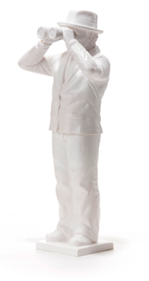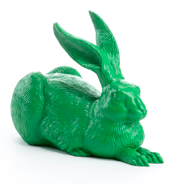In 2006, Ottmar Hörl developed today's Sponti gnome. Ever since, the figure has offered tongue-in-cheek provocation, called for playful disobedience and went off to many different private spaces scattered all over the globe.
by Eva Schickler, M.A., art historian
It provokes, triggers emotions, is loved and hated: the garden gnome is an ambivalent creature, at once attractive and ugly, a cultural phenomenon with a long tradition that goes back to the early Egyptians. Many an intellectual today still considers the garden gnome, the epitome of narrow-mindedness and bad taste, a crime against aesthetics. In the 1980s, when everything started, no-one would have been able to say that, in the guise of Hörl's global success model, the garden gnome was to conquer art.
"The garden gnome is the one figure most discredited in Germany. Does it have the potential to double as material for art? This was the question I was interested in," says Ottmar Hörl.
How everything started – the first garden gnome installations
As early as in the 1970s and 1980s, Ottmar Hörl used industrial products and industrially produced materials. He developed radical, innovative concepts for sculpture and photography. No other artist has dealt with the figure of the garden gnome in so much depth and consistency as has Ottmar Hörl, using it as material for art. Even before the growing trend towards modern "anti" garden gnomes originated in the 1980s, Hörl created his first works featuring serially produced garden gnome figures.
On 11 October 1985, for instance, he made a short performance at the Ersatzkunst, or Ersatz Art event, which was announced like that: "After an ear-piercing version of a Scottish Highlands musical theme, Ottmar Hörl will smash a number of garden gnomes in one go." The audience was amazed, amused, excited, was cheering and clapping. The figures used were identical to the model Ottmar Hörl had chosen for his large-scale Gelb-Syndrom [Yellow Syndrome] installation at the Galerie ak art gallery in Frankfurt am Main in the spring of 1985. He screwed down some sixty single garden gnomes either facing the wall or facing the bottom.
In both instances, the artist had opted for a classic garden gnome made of clay, which he chose to paint in a monochrome, light yellow colour. Monochrome-coloured garden gnomes were quite an unfamiliar sight in these days. Would the monochrome garden gnome, sixty-eight years after Marcel Duchamps' Fountain, after Dada, surrealism and modern art, put cultured art aficionados to the acid test?
Rolling change for garden gnomes
In 1994, Ottmar Hörl launched a new series called Rolling Change. He bought one thousand plastic garden gnomes in a provocative pose flipping the bird. He had the manufacturer colour the figures in monochrome blue. Without prior announcement, Hörl then set them up in public spaces in Seligenstadt. Groups of gnomes as well as single blue Sponti gnomes appeared at bus stops, were grinning down from staircases, and posing on Baroque balustrades in the monastery garden, calling to mind their historical forerunners. After a couple of hours, they had disappeared just as quickly as they had been set up. Passers-by had simply picked them up. This transfer from public to private space was deliberately intended, it was part of the concept. And it worked. On later occasions, Hörl's monochrome gnomes became part of different exhibitions, and at international art fairs, attracted the attention of the general public as much as that of curators and art collectors.
There was a constant series of installations featuring other types of garden gnomes with different gestures, meanings and titles: Bridge of Gnomes in 1997; Welcome in 1998; Ben in 2005. Bearers of Secrets (hear nothing, say nothing, see nothing) and the reissue of the Sponti were launched at the Amsterdam international art fair in 2006, followed by Poisoned in 2008 and Victory in 2012. For his monochrome figures, Hörl prefers to use traffic colours such as blue, red, white, black, green, and yellow, colours that suit public space.
Development of original garden gnome sculptures
In 1998, Ottmar Hörl introduced his signature stamp which has been imprinted on every one of his figures ever since. At the time, he also decided to develop the shape and appearance of his specific garden gnome models by himself, creating original prototypes and commissioning manufacturers based in Germany with the production of the figures required for his art installations. This approach is yet another testimony to Hörl's consistent way of thinking as an artist, deriving every part of his activities from social structures, the material employed, and the resultant findings. Furthermore, Germany is the cradle of garden gnome serial production.
Unlike all other garden gnomes, however, Hörl's gnomes are notable for their reduction to the essentials. Characteristic elements such as the beard, jacket, trousers, and footwear are deliberately rendered in a clear-cut shape. This gives the figures a fresh look that is both timeless and universal at the same time. In fact, Hörl's gnomes are the formal essence of the garden gnome as such. A difference becomes evident when comparing Sponti gnomes created in 1994 with those from 2006. By developing his own models for the gnomes, Ottmar Hörl has succeeded in capturing the essence of the garden gnome as an iconic archetype in cultural history. It comes as no surprise then that the figures have achieved cult status.
The titles of the different garden gnome figures and installations by Ottmar Hörl build bridges as far as meaning is concerned, while opening up mental spaces for debate. Hörl's Sponti gnome harks back to the so-called Sponti scene that had developed during the 1970s and 1980s in Germany, a movement of non-conformist leftist activists counting Joschka Fischer and Daniel Cohn-Bendit among them.
Sponti protesters regarded themselves as successors to the German left-wing extra-parliamentary opposition movement (APO) and student activism of 1968. Above all, they were active in university towns such as Frankfurt am Main or in West Berlin, and were notorious for their political interventions that seemed to have a spontaneous touch to them. According to the Sponti campaigners, the spontaneity of the masses was the one element in history that triggered revolutions. Their vision included a transformation of living conditions and experimenting with alternative forms of cohabitation. So-called Sponti slogans circulated in the media. Squatters campaigned for affordable living space, while activists also opposed nuclear power and promoted environmental awareness.
Once you have entered your personal data in the web form on this site, you may upload your photo for release on this website. You can decide whether you wish to reveal your name, together with the photo, to other participants and visitors. Your uploaded photo and personal data will be stored by us only for this one-time art campaign, and will not be revealed to third parties.
Please also read our data protection policy: got to data protection policy
Note on data entry:
Boxes marked with an asterisk (*) must be filled in. Participation is optional. All the data is provided by you voluntarily and without obligation.
Options for data storage, release, and use:
In the entry form, please tick [x] the check box(es) for the option(s) you wish to select. By clicking "continue", you give us your consent. You may withdraw your consent at any time by e-mailing us at info@ottmarhoerl.de.



